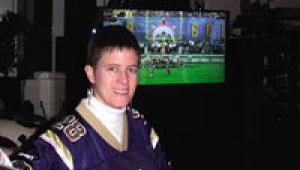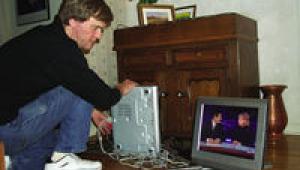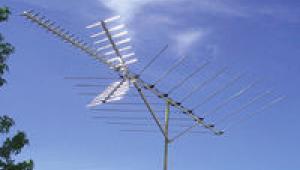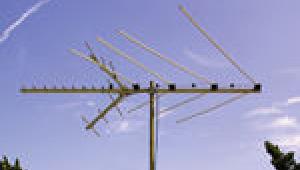Got HDTV? Page 2
Since the early days of radio, we've known that any antenna used for transmission and reception must match the desired frequency (or frequencies). Look at it this way: You wouldn't hook up a 6-inch tweeter to play back bass in your audio system, right? So why use an antenna that has little or no gain to receive your desired digital TV channels? The first step in choosing an antenna is to determine precisely which DTV channels have been assigned to your location. This information is available on numerous Websites, including www.nab.org/Newsroom/Issues/digitaltv/DTVstations.asp and www.fcc.gov/mb/video/files/dtvonair.html. The FCC's DTV table of allocations is a good place to begin your search. While a few channels have been changed in recent years, the TOA shows the assigned DTV channels for every existing analog TV station, organized by state. Figure 1 shows an example of a TOA for Philadelphia, PA.

Even though the table doesn't provide specific TV-station call signs, it's easy enough to read. The first channel (shown in red) is the existing analog TV station, and the second (blue) is the assigned DTV channel. The third (green) shows the licensed transmission power, calculated as effective radiated power or ERP. The fourth (brown) is the height of the TV station's antenna above average terrain, or HAAT. The rest of the numbers provide a comparison between signal coverage with the existing analog signal (area and population) and the new digital signal's predicted coverage area. While these numbers aren't as interesting, the last number (purple) represents the percentage of existing viewers who should be able to receive the new digital signal.
From this example, we can see that analog channel 3 (KYW-TV, the local CBS affiliate) also broadcasts a digital signal on UHF channel 26, while WPVI (ABC) on analog channel 6 is also digital on UHF channel 64. In fact, all of the digital channels assigned to Philadelphia stations fall within the UHF band (channels 14 through 69).
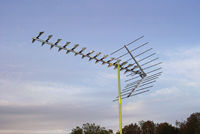 Using this table or the Websites listed, you can determine whether your location has primarily UHF digital channels (14 through 69), VHF channels (2 through 13), or a mix of both. If you live in a UHF-only market (which several top-20 TV markets are), then there's no sense in putting up a VHF antenna or even a combo VHF/UHF model. The reverse holds true for markets where the signals are all VHF.
Using this table or the Websites listed, you can determine whether your location has primarily UHF digital channels (14 through 69), VHF channels (2 through 13), or a mix of both. If you live in a UHF-only market (which several top-20 TV markets are), then there's no sense in putting up a VHF antenna or even a combo VHF/UHF model. The reverse holds true for markets where the signals are all VHF.
Make your antenna choices accordingly. UHF antennas are generally much smaller than VHF antennas because they receive signals with much shorter wavelengths. A signal from TV channel 3 has a wavelength of almost 5 meters (16 feet), whereas a signal from TV channel 26 has a wavelength of just 22 inches. As a result, it's possible to design UHF TV antennas with lots of gain that are also unobtrusive and will work indoors.
There's no correlation between an antenna's price and its performance, only needless marketing hype. I once built a $10 antenna out of plumbing-supply parts that outperformed a $400 commercial HD-ready antenna by a factor of 10 or more for UHF DTV reception. The reason was that I designed my antenna to have gain at UHF frequencies, while the more-expensive design was a low-band VHF-antenna design.
Now, there will always be exceptions to the rule. Some people have gotten satisfactory reception of UHF signals with plain-vanilla VHF antennas. I've picked up UHF DTV signals with a collapsible 19-inch whip antenna connected to the back of my DTV tuner, as well as a $3 bow tie. It all has to do with the strength of the DTV signal at your location.
How Much Is Enough?
There are several ways to determine how much signal you have to work with. The most accurate way is to use a spectrum analyzer, a device that lets you see the actual shape of DTV signals and measure their strength. A good satellite-antenna installer should have such a device. While they're expensive ($2,000 and up), they pay for themselves in no time by eliminating guesswork.
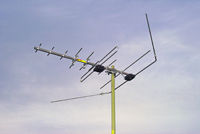 A second approach is to use a commercial signal-strength meter. These can cost a few hundred dollars but will provide an accurate readout of received signal strength. However, they can't tell you if signal echoes (multipath) are present. The receiver built into your DTV set-top receiver can also provide some indication of signal strength, but these built-in meters are often inaccurate, and you should only rely on them as a rough guide of what's possible.
A second approach is to use a commercial signal-strength meter. These can cost a few hundred dollars but will provide an accurate readout of received signal strength. However, they can't tell you if signal echoes (multipath) are present. The receiver built into your DTV set-top receiver can also provide some indication of signal strength, but these built-in meters are often inaccurate, and you should only rely on them as a rough guide of what's possible.
There's a very effective way to check signal quality that costs little to try out. Using a portable TV, look to see how cleanly you receive your existing analog VHF and UHF signals with a test indoor/outdoor antenna. Most DTV broadcast antennas are located on the same towers, mountains, or buildings as existing analog TV broadcast antennas. If you've chosen a UHF antenna and analog UHF reception is strong and clean with little noise and multipath, chances are you'll have good UHF DTV reception. The same holds true for VHF TV signals. Even a little noise doesn't mean you won't be able to receive DTV signals.
Antenna Designs
Choosing the right antenna can be confusing. The VHF and/or UHF TV channels you want to receive should steer your purchase, but you'll also need to consider the antenna's size and shape. It's time for a little tech talk, but I'll try to keep things simple.
 Antennas can have one, two, three, or more parts. The simplest type of antenna is the dipole, which resembles a pair of horizontal rods placed end to end. The most common version is a half-wave dipole, whose length equals half of the desired frequency's wavelength. Variations on the half-wave dipole include collapsible rabbit ears and the FM open-wire antenna that ships with A/V receivers. Even the $400 HD-ready antenna I mentioned earlier is nothing more than a half-wave dipole antenna with the two pieces of the dipole coiled into a helical shape. The wall-mount antennas sold by TERK, RadioShack, and others that resemble a huge submarine sandwich are also variations of a half-wave dipole. By itself, a dipole has no gain. Its coverage pattern (viewed from the top or bottom) resembles a figure 8. It receives signals best off of its sides, not off of its ends.
Antennas can have one, two, three, or more parts. The simplest type of antenna is the dipole, which resembles a pair of horizontal rods placed end to end. The most common version is a half-wave dipole, whose length equals half of the desired frequency's wavelength. Variations on the half-wave dipole include collapsible rabbit ears and the FM open-wire antenna that ships with A/V receivers. Even the $400 HD-ready antenna I mentioned earlier is nothing more than a half-wave dipole antenna with the two pieces of the dipole coiled into a helical shape. The wall-mount antennas sold by TERK, RadioShack, and others that resemble a huge submarine sandwich are also variations of a half-wave dipole. By itself, a dipole has no gain. Its coverage pattern (viewed from the top or bottom) resembles a figure 8. It receives signals best off of its sides, not off of its ends.
You can also make a simple antenna out of a loop of wire. The loop can be a perfectly round, square, or bow-tie design. The loop's size typically equals the desired reception frequency's full wavelength, and you can even flatten the loop. This loop is commonly used in VHF and UHF TV antennas because it's very easy to match to the feedline or coaxial cable. How well does the loop work? In one of my seminars on digital television, I took a piece of 16-inch-long wire, bent it into a full-wave loop, added a coaxial balun with clip leads and a short piece of coaxial cable, and immediately received the local CBS DTV station indoors.
While dipoles and loops are easy to make and use, they aren't directional. If you add another element—called a reflector—at a specific distance behind the dipole or loop, you in effect aim the antenna, which boosts its gain and makes it more directional (the same way you'd cup your ear to hear weak sounds better). A reflector can consist of one or several pieces of metal arranged in a V shape (called a corner reflector). A dish antenna is an example of a reflector, as is a curved or flat sheet of screen metal mesh. Even your body can function as a reflector at certain frequencies.

